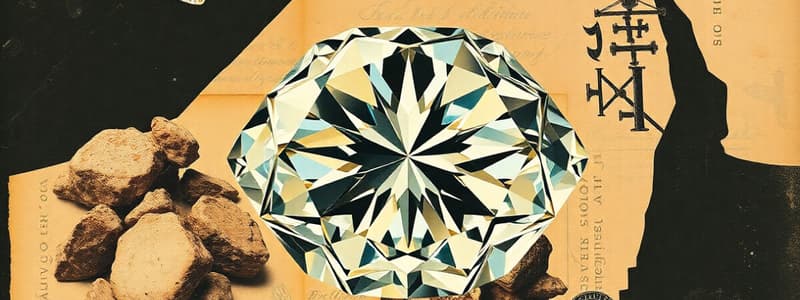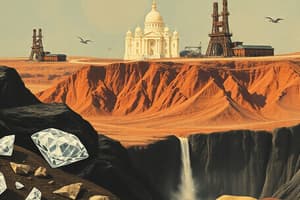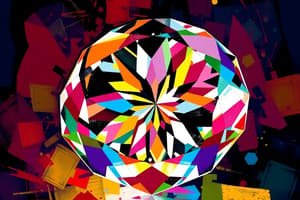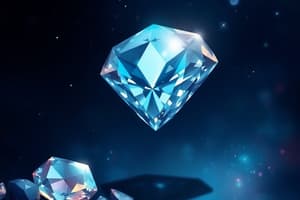Podcast
Questions and Answers
What property of diamonds makes them resistant to damage from strong acids?
What property of diamonds makes them resistant to damage from strong acids?
- Extreme density
- Imperviousness (correct)
- Crystalline structure
- High carbon composition
What two conditions are essential for carbon to crystallize into a diamond?
What two conditions are essential for carbon to crystallize into a diamond?
- Low temperature and high pressure
- Extreme heat and great pressure (correct)
- High temperature and low pressure
- Abundant oxygen and carbon
What aspect of diamond cutting most significantly contributes to a diamond's sparkle?
What aspect of diamond cutting most significantly contributes to a diamond's sparkle?
- The cutter's experience
- Creating facets to reflect light (correct)
- Using thin, metal disk saws
- The hardness of the diamond
Why was cleaving diamonds a 'nerve-wracking' experience?
Why was cleaving diamonds a 'nerve-wracking' experience?
What is the purpose of the revolving iron wheel in the final step of diamond cutting?
What is the purpose of the revolving iron wheel in the final step of diamond cutting?
Which of the following is the MOST accurate description of the Cullinan diamond's fate after its discovery?
Which of the following is the MOST accurate description of the Cullinan diamond's fate after its discovery?
What technical advancement allowed scientists in the 1950s to create synthetic diamonds?
What technical advancement allowed scientists in the 1950s to create synthetic diamonds?
According to the saying, what determines the best way to cut a diamond?
According to the saying, what determines the best way to cut a diamond?
In what decade did South Africa become a major source of diamonds?
In what decade did South Africa become a major source of diamonds?
Which mineral can be used to produce imitation diamonds?
Which mineral can be used to produce imitation diamonds?
What does it mean for a diamond to 'depreciate'?
What does it mean for a diamond to 'depreciate'?
What is graphite transmuted into when forming synthetic diamonds?
What is graphite transmuted into when forming synthetic diamonds?
What are the 4 C's that determine a diamond's value?
What are the 4 C's that determine a diamond's value?
What color of diamonds are considered very rare?
What color of diamonds are considered very rare?
What is the Star of Africa made of?
What is the Star of Africa made of?
How does the value of diamonds compare in value after they are purchased?
How does the value of diamonds compare in value after they are purchased?
What are diamonds likely made from?
What are diamonds likely made from?
What is a diamond made from?
What is a diamond made from?
What kind of appearance can a diamond have in its natural state?
What kind of appearance can a diamond have in its natural state?
What is the heaviest rough diamond on record?
What is the heaviest rough diamond on record?
Flashcards
Diamond Properties
Diamond Properties
The hardest substance on Earth, scratchable only by another diamond and impervious to strong acids.
Diamond Composition
Diamond Composition
A mineral form of carbon that requires extreme heat and pressure to crystallize.
Diamond Transformation
Diamond Transformation
Cutting, sawing, and polishing skills that transform a natural diamond into a scintillating gem.
Facets
Facets
Signup and view all the flashcards
Synthetic Diamonds
Synthetic Diamonds
Signup and view all the flashcards
The Four C's
The Four C's
Signup and view all the flashcards
Diamond Depreciation
Diamond Depreciation
Signup and view all the flashcards
White Diamond
White Diamond
Signup and view all the flashcards
Diamond Investment
Diamond Investment
Signup and view all the flashcards
The Cullinan Diamond
The Cullinan Diamond
Signup and view all the flashcards
Study Notes
- Diamonds are the hardest substance on Earth and can only be scratched by another diamond.
- They are impervious to strong acids.
- Light passing through a diamond travels at one-third its normal speed due to its density.
- Diamonds are a mineral form of carbon.
- Extreme heat and pressure are necessary for carbon to crystallize into a diamond.
- Diamonds are likely formed deep in the Earth within molten rock and then forced upward.
- In its natural state, a diamond can look like a lusterless, opaque gray or black stone, or even a nondescript piece of glass.
Diamond Cutting
- Transforming a diamond into a gem relies on the cutter's skill in cutting, sawing, and polishing.
- Historically, cutters would cleave diamonds with a precise blow, which was risky.
- Modern diamond cutting uses thin, metal disk saws.
- Polishing utilizes a revolving iron wheel to create facets.
- Facets are flat surfaces that reflect light, giving the diamond its sparkle.
- Diamond cutting can reduce a stone's size by up to 50%, but enhances its allure and value.
Diamond History and Origins
- Diamonds have been valued since antiquity.
- Originally, diamonds were thought to come only from India.
- In the 1700s, they were discovered in Brazil.
- In the 1800s, South Africa became a major source.
- Diamonds are now also found in Africa, Australia, and the United States.
- The Cullinan, discovered in South Africa in 1905, weighed 3,106 carats (over one and one-third pounds).
- The Cullinan was cut into nine large and ninety-six smaller gems.
- The largest of these is the Star of Africa, weighing 530.2 carats, presented to the King of Great Britain.
- The Star of Africa is the second-largest cut diamond in the world and is kept in the Tower of London in the British crown jewels.
- An 890-carat rough diamond found in South Africa in the early 1980s sparked excitement.
- It was cut to over 545 carats.
- The diamond was appraised at between four and twelve million dollars.
Synthetic Diamonds
- Attempts to create synthetic diamonds began in the 1890s.
- The challenge was replicating the extreme conditions of diamond formation.
- Scientists succeeded in the 1950s by producing pressures of 1.5 million pounds per square inch.
- This allowed them to transmute graphite into industrial-quality diamonds.
- These synthetic diamonds are used for cutting and drilling.
- Today, greater pressure produces artificial diamonds of gem-like quality up to one carat.
- Imitation diamonds can be made from zircon, which gains brilliance when exposed to high temperatures.
Diamond Value
- The value of a diamond depends on the "four Cs": cut, clarity, carats, and color.
- A first-quality diamond can cost as much as fifty thousand dollars.
- White diamonds are highly regarded, while yellow or brown tints are less desirable.
- Green and blue diamonds are very rare.
- Pink diamonds can sell for as much as a million dollars a carat.
- Diamonds depreciate substantially in value after purchase, making them a poor investment for the average buyer.
Studying That Suits You
Use AI to generate personalized quizzes and flashcards to suit your learning preferences.




